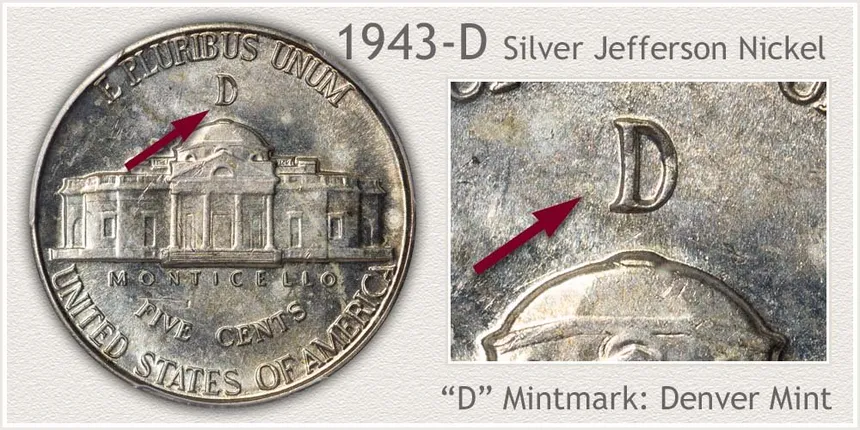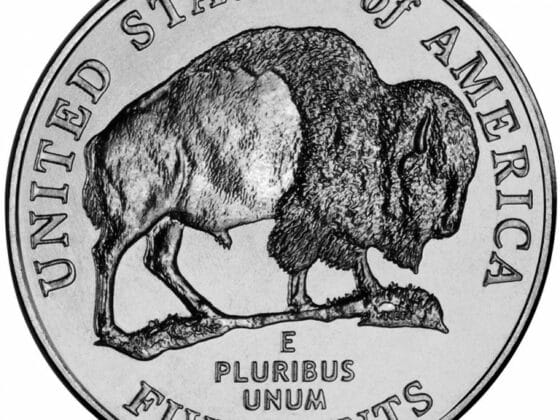The journey of the five-cent coin began in 1792 with the introduction of the half-disme, a silver coin considerably smaller than today’s nickel. Initially, Lady Liberty graced the obverse, while an eagle adorned the reverse, symbolizing freedom and strength. This design remained until 1837, when a laurel wreath became the new feature on the reverse. In 1913, the iconic Buffalo nickel emerged, showcasing a Native American on the obverse and an American bison on the reverse, a design that persisted for 25 years. The Jefferson nickel, introduced in 1943, featured Founding Father Thomas Jefferson on the obverse and his residence, Monticello, on the reverse. It remained in circulation until 2003.
Today, we aim to offer a comprehensive guide on this intriguing nickel variant. We’ll delve into its design, mintage figures, notable errors, and its current market value.
Table of Contents
The 1943 Nickel – Composition & Design

The Obverse Side

The obverse of the 1943 nickel showcases a dignified portrait of Thomas Jefferson, facing left. Skillfully crafted by designer Felix Schlag, the portrayal captures Jefferson’s reserved yet authoritative disposition. On the left, the U.S. motto “IN GOD WE TRUST” is inscribed, while the word “LIBERTY” and the minting year “1943” appear to the right.
Thomas Jefferson holds a monumental place in American history. He was a Founding Father and the principal author of the Declaration of Independence, the seminal document that birthed the United States.
The Reverse Side

The reverse spotlights Monticello, Jefferson’s architectural masterpiece and lifelong Virginia residence. Jefferson designed The estate over four decades and reflects his fascination with French architecture, an influence gained during his tenure as the American minister to France. Monticello is both a National Historic Landmark and a UNESCO World Heritage Site.
However, it’s crucial to note that Monticello operated primarily as a plantation, where Jefferson owned and enslaved hundreds of people. The presence of this fraught symbol on a commonly used coin denomination has sparked debate, but it remains part of the nickel’s design, reflecting complex historical perspectives.
In addition to Monticello, the 1943 nickel features another U.S. motto, “E PLURIBUS UNUM,” arching above the estate. Below, the words “FIVE CENTS” and “UNITED STATES OF AMERICA” round out the design.
The 1943 Nickel Dimensions and Composition
The U.S. Mint began minting five-cent coins composed of copper and nickel in 1866, lending the term “nickel” to these new coins. Interestingly, the older silver five-cent pieces continued to circulate alongside the nickels for a transitional period of seven years.
The composition of the 1943 nickel is unique, featuring an alloy of 56% copper, 35% silver, and 9% manganese. World War II necessitated this adjustment, as nickel became a critical resource for the war effort. The Mint adopted this tri-metallic composition, which remained in place until 1946, shortly after the war concluded.
Weighing in at 5 grams (approximately 0.1 ounce) and measuring 21.2 millimeters (around 0.8 inches) in diameter, the 1943 nickel is a testament to the historical period from which it emerged.
Related: The 1943 Silver Penny Value
1943 p silver nickel
Nickels from 1943 all have relatively large silver content, making them a highly desirable collector’s item.
The 1943 Nickel Value
How much is a 1943 nickel worth?
A 1943 nickel’s worth depends on several important factors. The crucial one is the state of your coin. Are the signs of wear and tear visible? Can you see all the intricate details clearly? Is the original luster still there? Coins are graded on a scale from 1 to 70, and the higher the grade, the more valuable the coin is.
A nickel from 1943 graded 1-30 typically sells for up to several dollars. Those graded 30-60 can reach the price of around $10 to $20. The five cents in mint state can command a price of thousands of dollars.
1943 Nickel Mintage & Value
The nickels were minted in three facilities in 1943. The total mintage was 390,519,000. The value doesn’t differ much between the three varieties.
1943 P nickel

The Philadelphia Mint produced 271,165,000 nickels in 1943. The coins that came from this facility didn’t contain mint marks until 1942. The Mint added the letter P to make differentiating wartime coins easier.
1943 P nickel Value
The value of a 1943-P nickel ranges from the coin’s face value to $14,687.50, which was the highest amount someone paid for this variety. This particular specimen was graded 68FS (full strike), but the nickels that are so well-preserved are very difficult to come across. Even if you do have a coin with a grade of 68, it doesn’t mean it can reach the mentioned price. For instance, one MS68 1943-P nickel was sold for only $600 in May of 2023.
1943 D nickel

Nickels from 1943 marked with the letter D come from the Denver facility. This mint made 15,294,000 five-cent coins, the least out of the three.
1943 D nickel Value
Nickels marked with the letter D and made in 1943 have similar price ranges to those produced in Philadelphia. The specimens in poor condition are worth a mere several cents. If a coin is in good condition, it can command a price of $5 to $20. If you have a 1943-D nickel in mint state, you will feel lucky to know about the collectors willing to pay thousands for this coin in perfect condition.
1943 S nickel

A 1943-S nickel was minted in the San Francisco branch. There were a total of 104,060,000 coins minted in total. They are marked with the S mint mark.
1943 S nickel Value
The value of nickels from 1943 from San Francisco is approximately the same as the other two variations of this coin. Generally speaking, the specimens in poor condition aren’t worth a lot, while those that are in good state sell for a lot of money. The highest auction price recorded was $9,775 in 2006. If your coin is graded 60+, it can be worth anywhere between $30 and $5,000+.
Rare 1943 Nickel Errors and Their Values
Mint errors significantly impact the value of a coin, often elevating its worth far beyond the face value. Before you consider selling a 1943 nickel, it’s advisable to have it professionally graded to identify any potential errors you might overlook. Renowned grading services like PCGS and NGC offer expert assessments. A few mint errors on the 1943 nickel stand out for their rarity and impact on the coin’s value.
Doubled Eye 1943 Nickel

The term “Doubled Eye” is a clever play on words referring to the “double die” error, pronounced the same way. This type of error occurs when the coin is struck twice by the die, resulting in a doubled image. In the case of the 1943 nickel, this doubling manifests in Jefferson’s eye—hence the name “Doubled Eye.” Depending on the coin’s condition, this particular error could boost its market value by hundreds of dollars.
1943 Nickel 3 Over 2

Another prominent double die error in nickels from 1943 is 1943/2. The year 1943 is stamped over 1942. The entire date is doubled, but the mistake is most visible on the number 3. This error can also significantly increase the value of a nickel, typically by hundreds of dollars.
Related: 1943 Copper Penny – Value, Mint Mark, Errors And More
Conclusion
The wartime era introduced several noteworthy modifications to the U.S. nickel, including a shift in metal composition from a copper-nickel blend to a copper-silver-manganese alloy. Additionally, the Philadelphia Mint marked its coins with a ‘P’ mint mark for the first time.
For collectors, 1943 nickels offer a fascinating blend of historical context and unique features. They are generally affordable and readily available unless you’re seeking coins in mint condition. Plus, they come with the potential for rare mint errors, adding an extra layer of excitement to your collecting experience.
Before entering into any transactions, you should have your coins professionally graded. This important step can save you time and money, ensuring you’re making informed decisions.
Happy collecting!











